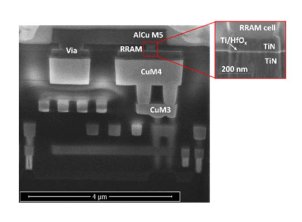CEA-Leti使用 RRAM 的突触构架以及模拟尖峰神经元,成功建立集成生物启发神经网络
Functionality of Circuit Presented at IEDM 2019 Was Demonstrated With Handwritten Digits Classification on a Tablet Screen
SAN FRANCISCO – Dec. 13, 2019 – Leti, a technology research institute of CEA Tech, has fabricated a fully integrated bio-inspired neural network, combining resistive-RAM-based synapses and analog spiking neurons. The functionality of this proof-of-concept circuit was demonstrated thanks to handwritten digits classification.
Resistive-RAM (RRAM) is a type of non-volatile random-access computer memory that works by changing the resistance across a dielectric solid-state material.
The research work presented at IEDM 2019 measured a 5x reduction in energy use compared to an equivalent chip using formal coding. The neural network implementation is made such that synapses are placed close to neurons, which enables direct synaptic current integration.
"The entire network is integrated on-chip," said Alexandre Valentian, lead author of the paper, "Fully Integrated Spiking Neural Network with Analog Neurons and RRAM Synapses". "No part is emulated or replaced by an external circuit, as in some other projects. It even was used in a live demo where users could draw digits with their finger on a tablet and it is classified after conversion into a spike train."
Spiking neural networks, also known as third-generation neural networks, are composed of bio-inspired neurons, which communicate by emitting spikes, discrete events that take place at a point in time, rather than continuous values. These networks promise to further reduce required computational power because they use less complex computing operations, e.g. additions instead of multiplications. They also inherently exploit sparsity of input events, since they are intrinsically event-based.
"To date, demonstrations of RRAM-based SNNs have been limited to system-level simulations calibrated on experimental data," the IEDM paper explains. "In this paper, we present for the first time a complete integration of a SNN combining analog neurons and RRAM synapses."

1. Demonstration of live handwritten digits classification
The paper explains that "the test chip, fabricated in 130nm CMOS, shows well-controlled integration of synaptic currents and no RRAM read-disturb issue during inference tasks (at least 750M spikes)."
"Data-centric workloads exhibited by Deep Neural Network (DNN) applications call for circuit architectures where data movement is reduced to a minimum," the paper says. "This has motivated architectures in which memories are spatially located near the computing elements. These memories must be very dense, preferably non-volatile and inserted into the computational dataflow, therefore RRAMs are excellent candidates to this purpose."
The study, which was supported by CEA-List, underscores CEA-Leti's expertise at manufacturing RRAM memories on top of CMOS wafers.

2. SEM cross-section of the RRAM cell monolithically integrated on the top of 130nm CMOS
Related Semiconductor IP
- Ultra-Low-Power LPDDR3/LPDDR2/DDR3L Combo Subsystem
- 1G BASE-T Ethernet Verification IP
- Network-on-Chip (NoC)
- Microsecond Channel (MSC/MSC-Plus) Controller
- 12-bit, 400 MSPS SAR ADC - TSMC 12nm FFC
Related News
- Xilinx投资一家致力于神经网络构架的公司作为其数据中心生态系统发展计划的一部分
- Cadence推出针对嵌入式神经网络应用的新一代Tensilica P6 DSP
- BrainChip和思科物联网创新中心签署协议以演示BrainChip的Spiking神经自适应处理器(SNAP)技术
- Cadence发布业界首款面向汽车、监控、无人机和移动市场的神经网络DSP IP